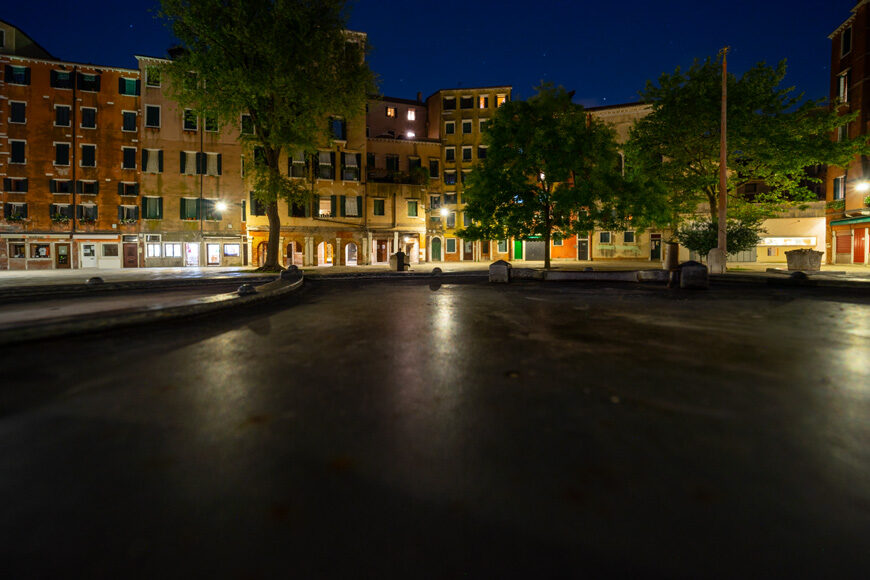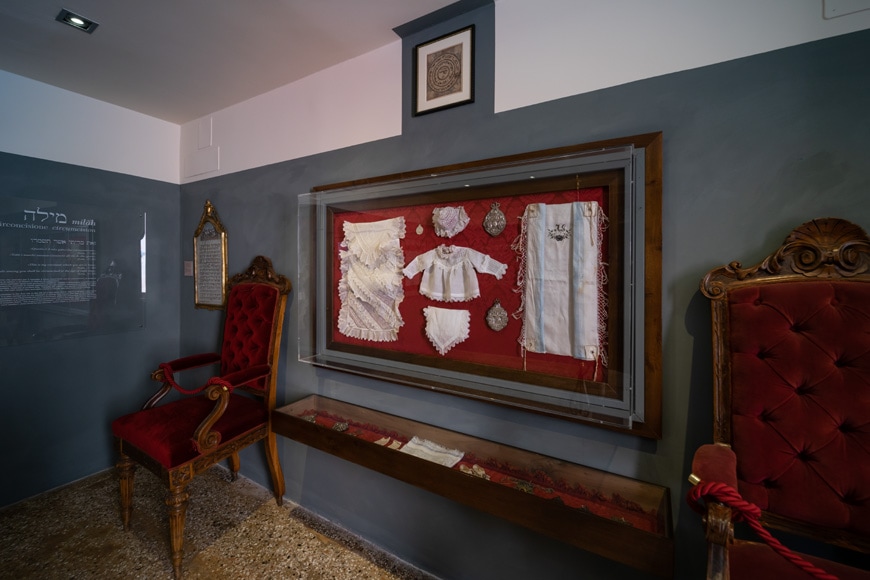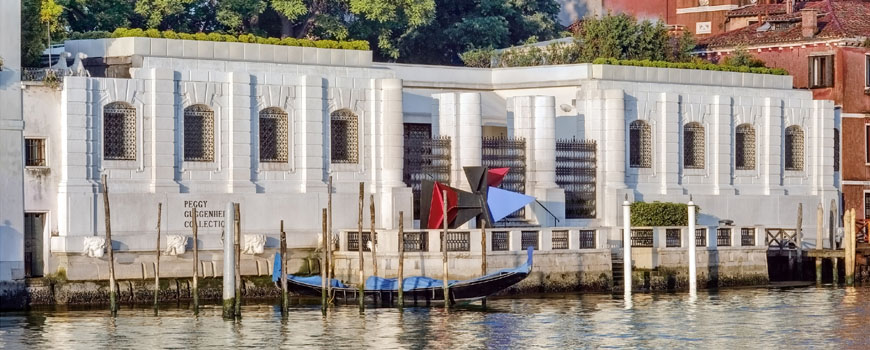Jewish Museum and synagogues, Venetian Ghetto, Venice
Veneto, Italy
Phone: +39 (0)41 715359
Website: https://www.museoebraico.it/en/

Located in the heart of the Venetian Ghetto, the Museo Ebraico (Jewish Museum) of Venice presents the history and culture of the Venetian Jewish community from the Middle Ages to the present.
The Museo Ebraico is more than a traditional museum, it is also an articulated architectural complex where some of the most symbolic places that key-pointed the long history of the Venetian Jews can be visited.
Cover image: the Venetian Ghetto at night, with the entrance of the Jewish Museum on the right. Photo © Riccardo Bianchini / Inexhibit
The Jewish community of Venice and the Venetian Ghetto
Ghetto is an old word that identifies the area, not far from the Santa Lucia railway station, where the Jews of Venice had been segregated from the 16th to the 19th century; the toponym possibly originated from a foundry, called getto in the old Venetian dialect, which was once located in the neighborhood. The Venetian Ghetto consists of three interconnected parts, the Ghetto Novo, The Ghetto Vecchio, and the Ghetto Novissimo; despite its name, the Ghetto Novo is the oldest and the first area inhabited by the local Jewish community.
The Jewish community of Venice, which amount to about 500 people today, at its peak reached a population of over 4,500 in the mid-17th century.
At the time, the community was actually composed of four Nations – German, Italian, Levantine, and Ponentine – each with its own traditions, sub-dialects, food recipes, traditional clothes, and rituals. Each Jewish “nation” also built its synagogue, called schola, (the Germans, who were mostly moneylenders and one of the wealthiest Jewish ethnic groups in Venice together with the Levantine merchants, built two of them) and followed its own variant of the Ashkenazi or Sephardic Rites. Two synagogues, the Great German Schola and the Canton Schola, are incorporated into the museum and are open to visits.
From the early Middle Ages century to the 16th century, the Jews were allowed to live everywhere in Venice and there was no such thing as a ghetto; many of them had immigrated to the relatively tolerant Venetian Republic from Spain, Eastern Europe, Germany, and the Middle East, escaping persecutions and forced conversions.
Yet, their condition in Venice started to worsen in the early 16th century, mainly because of the rising hostility of a number of Catholic clergy towards Jewish people and as a consequence of the economical crisis that followed the defeat of Venice in the Battle of Agnadello in 1509 which impoverished the Venetian population and sparked off social turmoil.
As a result, in 1516, it was ordered all Venetian Jews to relocate in a secluded area, the Ghetto Novo, wear identification signs (usually a yellow cap), pay heavy taxes, and refrain from any business activity other than loan banking, second-hand objects trade, and the medical profession.
The Jews’ segregation in Venice lasted for almost three centuries, until Napoleon ordered the destruction of the Ghetto gateways, in July 1797.
Despite the new-found freedom, the Jewish population in Venice declined constantly during the 19th and 20th centuries, mainly because many Venetian Jews relocated to other parts of the then-recently unified Kingdom of Italy, and, after the Fascist persecutions and the Holocaust (about 200 Venetian Jews died in the Nazi extermination camps between 1943 and 1945), moved to Israel and the United States.
Another view of the Campo del Ghetto Nuovo square in the Venetian Ghetto. Photo © Riccardo Bianchini / Inexhibit.
The Jewish Museum of Venice and the synagogues of the Ghetto
The visit to the Jewish Museum of Venice begins from the Great German Schola on the second floor. An Ashkenazi-rite synagogue built in 1528 and richly decorated during the Baroque period, the Great German Schola is a large irregular hall encircled by an elliptic women’s gallery. The Aròn Ha Qòdesh (Torah ark) is located opposite the bimah (pulpit); this unconventional arrangement (the pulpit was usually placed in a central position at the time) was probably decided for structural reasons, namely to reduce the loads on the fragile floor of the hall.
The Great German Schola in Venice, interior views; the synagogue also contains a magnificent 18th-century gilded-wood Aròn Ha Qòdesh (Torah Ark). Photos © Riccardo Bianchini / Inexhibit.
The visit continues throughout the museum’s permanent exhibition galleries, which comprise four rooms.
The first room focuses on Jewish festivities and features many ritual objects, including four 18th-century Torah crowns (‘ataròth) in embossed silver.
The second room presents a number of ancient textile objects, including beautiful 18th-century Torah mantles and ark curtains.
The central section of the permanent exhibition presents the history and culture of the Jews in Venice and their four Nations, and the evolution of the Venetian Ghetto.
The last gallery of the exhibition is dedicated to various milestones in a Jew’s life, from the Brit milah (circumcision) to the marriage ceremony, with several objects on view, including an ancient chuppah wedding altar.
The room dedicated to Jewish festivities features four 18th-century silver Torah crowns and various ritual objects. Photos © Riccardo Bianchini / Inexhibit.
The second gallery features several ancient Jewish ritual textiles. Photo © Riccardo Bianchini / Inexhibit.
In the permanent exhibition, an installation commemorates the victims of the Holocaust; about 200 Venetian Jews were murdered in the Nazi extermination camps from 1943 to 1945. Photo © Riccardo Bianchini / Inexhibit.
A view of the exhibition section dedicated to the history of the Venetian-Jewish community, and some Brit Milah (circumcision ceremony) exhibits. Photos © Riccardo Bianchini / Inexhibit.
The visit to the Museo Ebraico ends with the 16th-century Canton Schola located on the top floor, the second Ashkenazi-rite synagogue of the Venetian Ghetto. The synagogue is a rectangular room decorated with Baroque furniture and gilded carved wood columns and panels; as in the Great German Schola, also here the Aron is located opposite the bimah. Another peculiarity of the Canton Schola is its eight painted panels depicting landscapes that evoke episodes from the book of Exodus. The women’s gallery is located on one side of the hall and is preceded by a permanent Sukkah room dating to the mid-19th century (a sukkah is a temporary hut Jewish people build during the Sukkot festival to celebrate the Departure from Egypt and the Exodus towards the Land of Israel/Eretz Yisrael).
The Jewish Museum of Venice also contains a gift and book shop; it does not have an internal cafe; yet, apart from several generic bars, two kosher restaurants and a kosher bakery are located in the Ghetto.
Bimah and Aròn Ha Qòdesh in the Canton Schola synagogue. Photos © Riccardo Bianchini / Inexhibit.
The 1858 sukkah room in the Canton Schola synagogue. Photo © Riccardo Bianchini / Inexhibit.
How our readers rate this museum (you can vote)
copyright Inexhibit 2024 - ISSN: 2283-5474















 (13 votes, average: 3.92 out of 5)
(13 votes, average: 3.92 out of 5)
